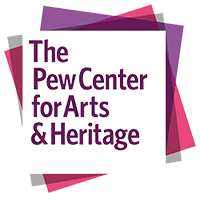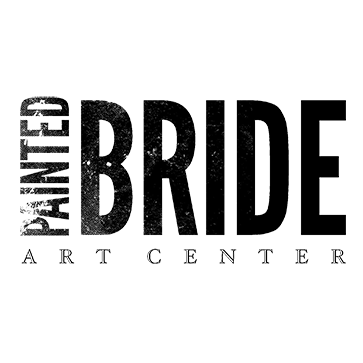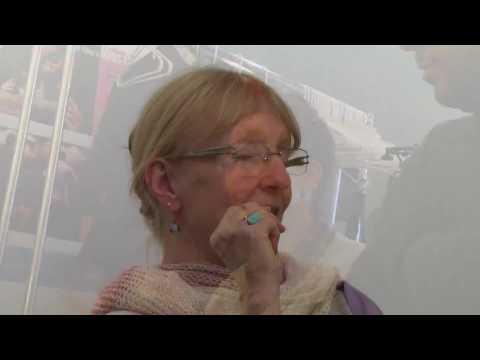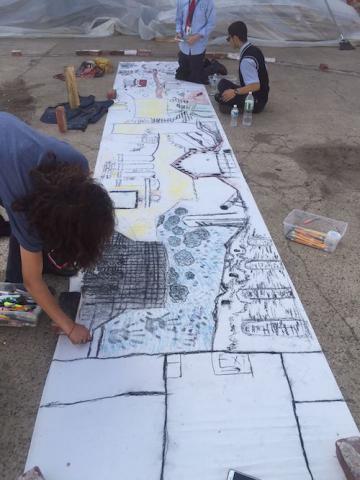Project Note
Project Note: Faustin, Marty, Reggie
by Lauren Bakst and Talvin Wilks
Faustin Linyekula, Marty Pottenger, and Reggie Wilson are the three Re-PLACE-ing Philadelphia Artists/Thinkers. Project Notes document and articulate their processes and engagement with Philadelphia they develop new work that will be presented here in April, 2016.
Over the past few weeks, Talvin Wilks and I have been meeting to discuss our reflections on Re-PLACE-ing Philadelphia. As Dramaturgical Documenter and Interlocutor respectively, Talvin and I have both shared a situated-ness simultaneously inside and outside the project’s container. We step in, or look in, in order to reflect back.
As we approach the culminating performances by Reggie (April 14-16), Faustin (April 21-23), and Marty (April 22-24), Talvin and I posed the following questions to each other in order to share what we've observed and what we are excited and inspired by.
We hope you’ll join us on Tuesday, April 19th at the Bride as we continue these thoughts in conversation with the artists and with you. More info here.
—Lauren Bakst, Interlocutor
What is your perspective on the project’s relationship to the city?
Lauren Bakst: When I think about the web of engagements this project has highlighted and enacted, I keep coming back to walking. Walking through a city, one encounters multiple layers of phenomena that are constantly changing—appearing and disappearing. Walking through a city, the body is foregrounded, moving through, and re-situating the phenomena encountered.
As Rebecca Solnit writes, “Walkers are ‘practitioners of the city,’ for the city is made to be walked. A city is a language, a repository of possibilities, and walking is the act of speaking that language, of selecting from those possibilities. Just as language limits what can be said, architecture limits where one can walk, but the walker invents other ways to go.”
In my view, this project has been an invitation—to both the artists and the community—to walk in, through, under, around, and with the city. That invitation has generated and shed light on many simultaneous walks through various layers of Philadelphia—from the physical to the digital, the geographic to the metaphoric, the personal to the historical.
Talvin Wilks: I think the Bride has taken on a challenging task - how do you seed systemic change for a city through artistic practice. The results are not immediately what one would necessarily expect from a commission. They sought to create community in addition to the creation of the work itself. Much of my observation has been that this is just the beginning, the tip of the Philly iceberg, but it is clear that the terminology has been challenging and perhaps even off-putting. Being the great optimist, I do not necessarily see this as a bad thing for Philly to wrestle with. It is always very challenging to unearth what has been hidden or forgotten. I understood it from the very beginning, Re-PLACE-ing has never been about replacing, it has always been about re-thinking the way we understand PLACE, this place [Philadelphia], and the history that is embedded in this place; “resituating,” is the word that Reggie Wilson used in one of our conversations. The Bride is saying that there is a missing history within the confines of what has already been determined as historic Philadelphia, the people, stories, communities that have been left out. Re-PLACE-ing is merely re-SITUATE-ing the lens of that history. So, for me, the project by its very nature has been designed to do a bit of destabilizing, challenging the status quo and that seemingly “fixed” lens of history.
Even I have internalized the language and process so much that I recently commented on the project in an interview while I was in Minneapolis –
“I’m working on a project at The Painted Bride that's gotten very controversial because of the language that they use, the heading, you should check it out. it’s on re-place-ing.org, but it’s called Re-PLACE-ing Philadelphia... And people have been incredibly offended by the word ‘replacing,’ “What are you replacing?” And they are reading it as something that's trying to do its own kind of erasure as opposed to something that's actually trying to broaden and enhance what the history really is.
The history is already a history of replacement and displacement, completely erasing the people who still exist on the fringe. I mean when you travel through Philadelphia, there are roads and rivers with Lenape names or Native American names! (Cage [the interviewer] gestures to the window suggesting similarities between Philadelphia and Minnesota.) Yeah, exactly! And you go, “what, what, what?” So, the point is you can maybe forget about a people but you can’t erase the name, the place. You know, that's what’s so beautiful about the project; we know there's another history here. You can’t avoid it. You continue to avoid it to your detriment. I think that's the key.”
Have you observed any a-ha moments or revelations by the artists-in-process?
TW: The most fascinating thing to me has been the way in which each artist has found a unique entry point and embedded a personal practice into the exploration. Obvious, of course, but quite revelatory when you witness it. I don’t believe that any of the artists have approached the project in the way that was expected, the Painted Bride staff have expressed as much throughout the process. The ideas that seemed clear and direct were never clear and direct.
For Marty, I wrote:
“Her spirit is one of collaboration; she wants to be informed both content-wise and conceptually by the people she encounters and the ones who will be involved in the final production. In this way, the project will organically manifest by the consistent mining of thoughts, ideas and experiences, the more the better. She is in great need of interaction and engagement; from there the “story” will reveal itself. Pottenger is not a traditional scriptwriter; she is a serious thinker, talker and listener. Her process is one of engaged critical thinking out-loud in community. Her performances are social forums that privilege conversation, an opportunistic dialogue informed by deep research and community investigation.”
For Reggie, I observed:
“His first instinct is to search for information that is housed in each individual. Because the artists he has selected have been doing a lot of work in the community and have a relationship with the community, he is relying on that information to provide a type of access for him. It is a brilliant strategy, to seek out the information that is embedded in these different people. According to Wilson, “if the Trinidadians can help me locate this information, or if [the people] can be my entre into the culture of Zimbabwe, then why not apply the same practice to Philadelphia?” He seeks out the miniscule, “a hidden place within a hidden place within a hidden place,” creating an industry, the agency and the importance of performances in the diaspora, a way of seeing it through the people who live there. In a way, Philly gains a new reflection from the diaspora, people from other places, now living and creating work in Philadelphia.”
The gaze is in and out.
From Faustin I’ve only collected an inkling of his view, utilizing his language of “art citizen,” he too reflected on the challenges of the open landscape in Re-PLACE-ing Philadelphia and how best to fill it, feel it. Or the idea of “the work already building a bridge to the future, the future Bride in the present.” I coined it, “The Bride as future Brid(g)e.”
LB: As I try to answer this question, I realize I am more so revealing the a-ha moments I’ve experienced as a result of witnessing the artist’s work in the context of Re-PLACE-ing Philadelphia.
The first thing that comes to mind is Reggie’s “liberty walk”—a story Reggie told during the "Artist and Civic Imagination" talk that took place last October. What started out as a walk from Reggie’s hotel to see the Liberty Bell became a series of detours landing him at less-traversed markers of American history. In telling us about his encounter with Philadelphia’s historical architecture, Reggie brought us with him on that walk, giving us a window through which to see these familiar (or unfamiliar) places anew.
Just a few weeks ago, I read a draft of Marty’s script. Since my first conversation with Marty in March of 2015, she has always focused on the necessity of listening to others. Her many “Tree Story” events have echoed this commitment, creating vital spaces of exchange for people who would otherwise not be in a room together. It has been moving to witness this process come full circle—in listening to the layers upon layers of narratives embedded in this place, Philadelphia, Marty has found a way of returning to her own history.
In Faustin’s process, I have witnessed a kind of intuitive unearthing take place. From his first conversations with the Bride, Faustin introduced the proposition of a circle. He asks, “How can everyone take responsibility towards making a circle, or at least creating the possibility of a circle, of a community?” Faustin reminds us that the circle is never a given—it is always already broken. With this knowledge, how can we take responsibility, as he says, to "remake the circle again even if it's temporary," "to reimagine who we are with a full awareness of the ruins around and inside us?” With his new work, Philly Files, Faustin is shaping a space for everyone involved—the performers, the audience, the community, the Bride—to do just that. The work invites, and maybe even demands, that we step into this place of deep questioning, consideration, and connection with him.
What are you excited about in the upcoming work?
TW: What’s underneath, what’s just on the fringe, who’s standing right next to you? The lens of history is a selective lens; Re-PLACE-ing Philadelphia has an opportunity to shift that lens, at least a beginning…the future Bride in the present. The works, or the process of creating the works, have navigated past, present and future, because that is clearly the demand. This is not historicizing or creating a piece of documentary theatre/performance, this is archive as generative, history as future process. How do you use a process of reflecting, looking back as a forward moving/making process? I’m looking forward to seeing how the works trigger this, wrestle with this uncomfortable notion of living on top of an erased history. The excitement of what will be unearthed by these outsider (now insider) revelations. These works are the catalysts, not the answers, the new questions, new thinking, new reflections that may challenge or affirm the known and reveal the unknown. These are not ending steps; these are first steps into that future Brid(g)e. That is very exciting.
LB: Re-PLACE-ing Philadelphia has been a kind of quest for new cultural archives. The artists have helped me understand that it might not be about the discovery of something “new,” but more so a tending to, a gathering, an unearthing of the archives within what has been there all along. The way the archives of one body multiply as they meet other bodies, and how the city unfolds through these meetings of place, memory, and history. The cultural archives are in the works of the artists and the micro-communities they have each built around their work. How will this knowledge be shared in the space of performance? How will it meet the community-as-witness? How will the works speak back to the city? I am excited to be in these spaces of action-and-reflection that these new works are generating.





